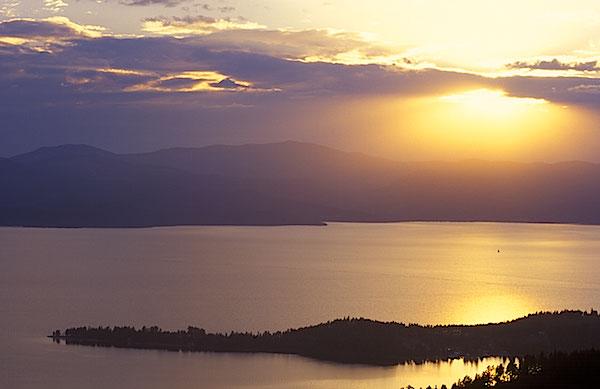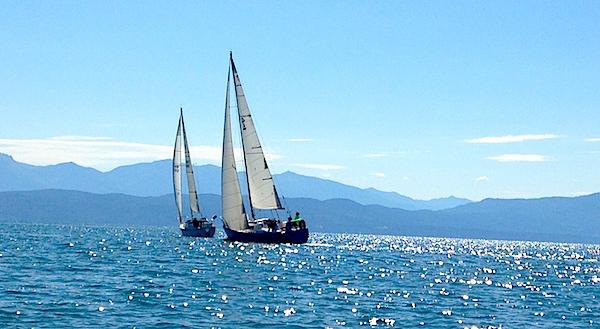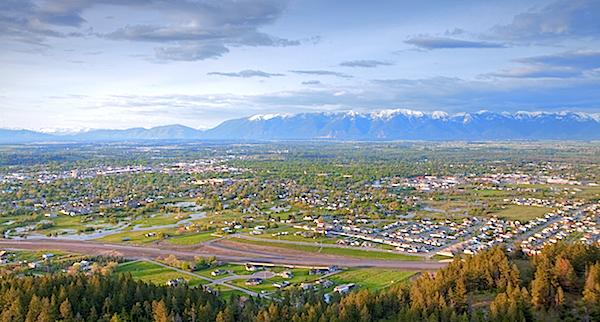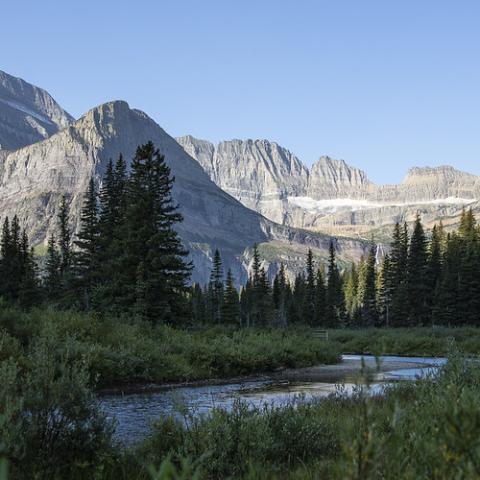
Flathead Lake at sunset/Chuck Haney
Flying into Kalispell, your eyes dart here and there, trying to take in all the peaks clawing skyward.
While this laid-back Montana town is the western gateway to Glacier National Park, it's also seated in the Crown of the Continent, an idea as much as a phrase that captures Rocky Mountain wildness.
It's a 10-million-acre chunk of wildness, one that overlaps the U.S.-Canadian border and comes with rivers swift, cold, pristine, and brimming with trout; forests that still hold bears and wolves, elk and deer, wolverine and fox; and adventures that will wear you out.
It's a large swath of the Northern Rockies that, once you get away from roads and towns, looks unchanged from when 19th century mountainmen roamed the landscape and Lewis and Clark passed through to the south.
There are mountain ranges -- Mission Mountains, the Flathead Range, Swan Range -- that hold deep forests clinging to the spine of the Continental Divide as it soars above 8,000 feet. Complementing these timberlands with their crags are wilderness areas equally evocative in name -- the Great Bear Wilderness and Scapegoat Wilderness that are part and parcel of the Bob Marshall Wilderness Complex.
Stretching north into Canada, this rugged Crown counts both Glacier and Waterton Lakes national parks, two siblings tied at the US-Canadian border that together are known as the Waterton-Glacier International Peace Park, designated as such in 1932 to "commemorate the peace and goodwill our two nations share," notes Parks Canada.
Rivers that feed into both the Atlantic and Pacific -- and even Arctic -- oceans find their way into the world here. From Triple Divide Peak on the eastern side of Glacier snowmelt trickles into Pacific Creek to head west, Hudson Creek to flow north, and, naturally, Atlantic Creek to move east.
For travelers seeking solitude in an earlier era, this is the place.
Located on the western edge of the Crown, Kalispell is a resting stop, of sorts. Or, better yet, a launching point.
Lying due east of the Salish Range, the town's name evolved from the Salish word, "qlispel," which tranlsates to "flat land above the lake." The lake in question is Flathead Lake, a nearly 30-mile-long, north-south running body of deep, cold water that is the largest natural freshwater lake west of the Mississippi. The flat land along the northern tip of the lake holds this city of roughly 21,000 that lies about 45 miles from West Glacier, the western terminus, by road, of Glacier National Park.

From mid-July through August cherry stands blossom along the road that loops Flathead Lake/Donnie Sexton, Montana Office of Tourism
Unlike many gateway towns that practically border their national parks, Kalispell comes with a little breathing room between it and Glacier. And that is a very good thing if you're looking to savor the essence of not just a national park, but the region that surrounds it.
Stay in Kalispell and your first waking thought is not to gobble down breakfast and get through the park entrance. Rather, you can ponder your options over a hot cup of coffee or tea. (Montana Coffee Traders at 328 W. Center Street can fix you up with the hot beverages as well as sumptuous omelets, wraps and pancakes, though for some curious reason they're closed on Sundays. Places that are open on Sundays include Split Rock Cafe, The Knead Cafe, Sykes Diner, and the Montana Club).
You could spend the day sailing, fishing for pike, trout, bass, or kokanee salmon, or learning how to paddleboard on Flathead Lake. Or you might want to explore the Flathead National Forest and the Bob Marshall Wilderness Complex.
You just might want to enjoy driving the loop that wraps around Flathead Lake, with stops in the art gallery town of Bigfork (the town's art festival is August 1-2; the Whistling Andy Distillery is here, too, if you'd like to sample some of the spirits), at one of the cherry stands once the orchards ripen and begin to be harvested in mid-July, or at one of the other whisky distilleries that, like brewpubs in many other states, seem to rise up in quite a few towns and which offer their own distinct impressions on just how a whisky should taste. One distinction is a spirit made with, depending on the distiller, the juice from one or two pounds of cherries.
If you're inclined to adult beverages, pick up the Breweries, Wineries & Distilleries brochure at the chamber bureau and you'll get directions to eight area distilleries, wineries, and breweries.

St. Mary Lake in Glacier National Park/Donnie Sexton, Montana Office of Tourism
That's the problem and the beauty of basing a Glacier Park vacation at Kalispell. You are 45 miles from the park, but you have many more options for exploring the Crown of the Continent than if you stayed inside the park...if you were even able to find a room there in mid-summer.
Because it is 45 miles from Glacier, Kalispell is not your traditional tourist town; it's not overrun by T-shirt and souvenir shops. The economy is driven by many sectors. There's certainly the outdoors community, thanks not only to the national park and national forests nearby, but also by water-borne activities spurred by Flathead Lake, and nearby ski resorts. For backpackers, Kalispell is home to Counter Assault, which manufacturers bear spray.
But there also are businesses that feed into regional trade, and even a thriving arts component.
Things might have been different had the Great Northern Railway not decided in 1904 that Whitefish off to the west made a better division point for its trains and moved away from Kalispell. As a result, the town in effect was shunted off onto a siding. It was not an unkind move in the long run.
Locals were the predominant demographic I encountered during an early Spring visit, even in restaurants such as Hops Downtown Grill (which offers not only 100 craft beers, but also yak burgers that get their main ingredient from a nearby herd) or Brannigan's Irish Pub, a raucous place loud with locals who, as I dug into a steaming plate of corned beef and cabbage, made it futile to listen to any of the sporting events on the big-screen TVs scattered about.
If there's a vibe about town, it could be simply defined as "do your own thing."
That could range from exploring the Conrad Mansion Museum, where you'll get a feel for Charles E. Conrad, who founded Kalispell in 1891 (19 years before the national park was established) or admiring the artworks in the Hockaday Museum of Art on 2nd Avenue East, which has a gorgeous collection of paintings from Glacier's early days as a national park, including some from John Ferry, Charles Russell, and Adolph Heinze. (Find yourself in Kalispell on or after July 23 and catch the museum's Piecing Together a Changing Planet: Climate Change in America's National Parks exhibit. This exhibit features 26 quilts created by 22 Florida artists. It debuted at Biscayne National Park on December 5, 2014, and will be shown around the United States at only nine more locations. The building which houses the museum was built thanks to a $10,000 gift from 19th century industrialist Andrew Carnegie.)

Catching the breeze on Flathead Lake is a popular summer diversion/Discover Kalispell
Drive a few minutes out of town to Herron Park and you could walk (or mountain bike) some, or all, of the roughly 15 miles of trails or, for a better overview of the area, head 6 miles to Lone Pine State Park. Along with picnic spots and hiking trails, there's an overlook just minutes from the visitor center that shows off both Flathead River and the roof of Glacier National Park. Inside the visitor center are exhibits that detail local wildlife and vegetation, and in winter this is where you can pick up some snowshoes to hit the trails.
Plan your visit for September -- the start of arguably the most beautiful season in Glacier National Park -- and you can catch the Montana Dragon Boat Festival (Sept. 12-13) on Flathead Lake. This weekend celebration of racing really, really big boats powered by 20 paddlers has in past years drawn men's and women's teams from Montana, Alberta, Washington state, California, Minnesota, and even Las Vegas, Nevada.
Due to Kalispell's location on the western side of Glacier, quick day trips into the park can be accomplished. You might stop at Lake McDonald for a scenic boat ride on the lake, take a stroll along the Trail of the Cedars Nature Trail or opt for the longer hike to Avalanche Lake, and then find yourself on Logan Pass in search of mountain goats (they're easily found).
You could just as easily head north from West Glacier along the Outside North Fork Road to reach some secluded paddles on Bowman or Kitna lakes, or launch a backcountry trek of a few, or a lot, of days from any number of trailheads that dot the road. Or simply enjoy a day trip to Polebridge, Montana, with a stop at the historic mercantile and bakery that is "located close to Glacier National Park and far away from everything else."
For its part, Kalispell, fortunately, is close enough to all the main attractions of the Crown of the Continent.

Kalispell, Montana/Chuck Haney




 Support Essential Coverage of Essential Places
Support Essential Coverage of Essential Places







Comments
Great article! Kalispell has grown so much since I lived in nearby Columbia Falls, eons ago. I vowed to myself if I ever decided to move back to Montana, Kalispell would be the place I'd go to live. It's a nice-sized town near the edge of Glacier National Park, with (now) plenty to do, and a little less expensive than nearby Whitefish.